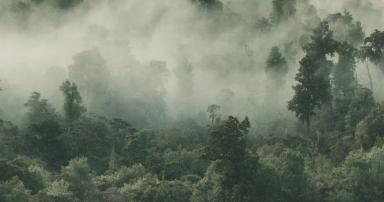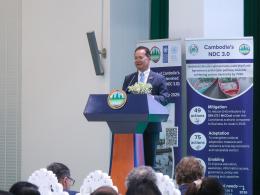Srun Bun Thuon, a fisherman from the Koh Kong province on the southwestern coast of Cambodia, saw his family’s life crumble seven years ago when he had to sell off his house to repay a microfinance debt. “Even our daughter’s earrings were not spared. I took them off her ears to sell to pay off the debt,” says Nhek Sophy, Srun Bun Thuon’s wife, recalling the family’s misfortune in 2007.
But the couple managed to get back on their feet since then with loans from their village’s savings fund, where villagers, bound by mutual trust, are pooling money to use for small businesses or emergencies when banking services are out of reach.
The fund is part of a broader climate change adaptation project, funded by Sweden and Australia. The project, jointly overseen by UNDP and the Global Environment Facility (GEF), helps preserve a swath of mangroves linked to the 23,750-hectare Peam Krosorp protected area, about an hour ride by boat from the provincial town.
“These mangroves work as a natural buffer to protect villages against storm and coastal erosion in addition to providing habitat for many marine species,” explains Hun Marady, the provincial chief for department of environment. “They are the resource locals depend on for survival."
The mangroves used to be destroyed by villagers to feed charcoal kilns and make way for shrimp farming. To reverse the trend authorities began engaging the villagers in the conservation and created a savings group in the village to offer them loans as an alternative to charcoal business.
“If people borrow from outside, the money flows out of the village by way of repaying the loan and interest. On the contrary, our savings group keeps the money moving right here in the village,” says Lorn Rith, the head of the conservation committee in the village.
According to Lorn Rith, 10 million riel (US $2,500) is signed out in loans every month. The amounts range from $250 to $2,000 per client, at a 2 percent interest per month compared to the 2.7 percent levied by microfinance firms.
Clients decide how much money a day they put in the village’s savings. A bookkeeper goes door to door to collect the contributions. Once a month the group meets to certify the record, process new loans and repayments, and tally the balance sheet. At year’s end, the accumulating interests are calculated and divided up among the members.
“It is more convenient to take a loan from the community savings, and the benefits just go back to the community,” says Phoeung Phieng, a 58-year-old mother.
Recently she came to the community centre to pay an installment for a loan she had taken to buy a motorboat to transport goods and passengers. Out of the $61.25 she owed, she was able to pay only $12.50 and $10 interest. The boat taxi business only broke even the previous month, she said, so she asked to defer the full installment to a later date.
“With lenders from outside, installment must be made in the exact amount due and on time,” she said, adding that borrowers get penalties when they fail to meet the requirements.
As for Srun Bun Thuon, the fisherman, he returned to his village after eking out a living as construction worker in Phnom Penh for a year and borrowed money from the savings group to restart his crab-fishing business. After six years of hard work, he managed to build a new wooden house. A motorbike and a motorboat are the latest additions to his family’s assets.
“We get our lives back thanks to the help of the community’s savings group,” he says.
To read this article and other climate related news from UNDP, please follow this link



